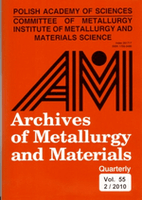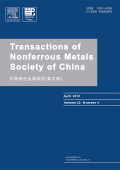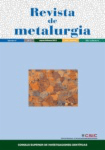
METALLURGICAL AND MATERIALS TRANSACTIONS B-PROCESS METALLURGY AND MATERIALS PROCESSING SCIENCE
Scope & Guideline
Exploring Innovations in Process Metallurgy and Material Science
Introduction
Aims and Scopes
- Process Metallurgy:
The journal extensively covers the thermodynamics and kinetics of metallurgical processes, including the reduction of metal ores, refining of metals, and the behavior of metallurgical slags. - Materials Processing Science:
Research on the processing of materials, including casting, welding, and additive manufacturing techniques, is a significant focus area, aiming to improve the mechanical and physical properties of metals and alloys. - Computational Modeling and Simulation:
Numerical simulations and computational models are frequently employed to predict and analyze various metallurgical processes, including fluid dynamics, heat transfer, and solidification phenomena. - Innovative Materials and Alloys:
The journal publishes studies on the development and characterization of new materials and alloys, including high-performance steels, titanium alloys, and composite materials. - Environmental and Sustainable Practices:
Research addressing the environmental impact of metallurgical processes, including recycling of metals and sustainable practices, is also a core area of interest. - Experimental Techniques:
The journal emphasizes the use of advanced experimental techniques, such as in-situ observation and high-temperature measurements, to gain insights into metallurgical processes.
Trending and Emerging
- Machine Learning and AI Applications:
The integration of machine learning and artificial intelligence in predicting material properties and optimizing metallurgical processes is increasingly prevalent, highlighting a trend towards data-driven methodologies. - Sustainability and Recycling:
Research focused on sustainable practices, including recycling of metals and reduction of environmental impacts of metallurgical processes, is gaining traction, aligning with global sustainability goals. - Advanced Materials Characterization Techniques:
There is a growing emphasis on using advanced characterization techniques, such as in-situ observations and high-resolution imaging, to understand material behavior at the microstructural level. - Electromagnetic and Innovative Processing Techniques:
Emerging processing techniques, including electromagnetic stirring and novel casting methods, are becoming popular topics, reflecting advancements in manufacturing technologies. - Multiscale Modeling Approaches:
Research employing multiscale modeling techniques to understand complex interactions in metallurgical processes is on the rise, facilitating deeper insights into material behavior.
Declining or Waning
- Traditional Metallurgical Techniques:
Research focusing on traditional techniques such as basic casting and forging processes has been declining, as the journal shifts towards more advanced and innovative methodologies. - Basic Thermodynamic Studies:
While thermodynamics remains essential, papers purely focused on basic thermodynamic principles without application to modern processes or materials have seen a reduction in interest. - General Reviews on Established Processes:
General review articles summarizing established processes in metallurgy without new insights or advancements are less frequently published, reflecting a trend towards more cutting-edge research.
Similar Journals

Russian Journal of Non-Ferrous Metals
Fostering Excellence in Materials ResearchThe Russian Journal of Non-Ferrous Metals, published by PLEIADES PUBLISHING INC, serves as a vital resource for researchers and professionals in the fields of materials science and engineering. With a dual ISSN (1067-8212 for print and 1934-970X for online), this journal has been instrumental in disseminating cutting-edge research from 2007 to 2023. Specializing in the mechanics of materials, metals and alloys, and the study of surfaces, coatings, and films, it provides invaluable insights into the latest advancements and applications in these areas. Although currently categorized in the Q4 tier for mechanics of materials and surfaces, and Q3 for metals and alloys in the 2023 rankings, its commitment to quality research is reflected in its Scopus metrics, ranking it within the competitive spectrum of its fields. While not an open access journal, it remains a crucial academic platform for fostering knowledge exchange among professionals and scholars. By publishing high-quality articles, the Russian Journal of Non-Ferrous Metals contributes significantly to the ongoing dialogue in metallurgical science and engineering.

ACTA METALLURGICA SINICA
Advancing the Frontiers of Metallurgy and Materials ScienceACTA METALLURGICA SINICA, established in 1978 and published by SCIENCE PRESS, stands as a preeminent journal in the fields of metallurgy and materials science. This journal is particularly revered for its contributions to Metals and Alloys, Mechanical Engineering, Geotechnical Engineering, and Mechanics of Materials, with a commendable Q1 ranking in Metals and Alloys and notable placements in other engineering disciplines. With a robust history of facilitating scholarly communication from 1978 to 1991 and consistently since 1996, the journal provides a vital platform for researchers and practitioners to disseminate significant advancements in material science. Despite being a subscription-based journal, ACTA METALLURGICA SINICA remains pivotal, holding a Scopus ranking that places it in the top tiers of its categories, fostering an environment ripe for innovation and collaboration. This ensures that the journal remains central to the ongoing discussions and developments within the metallurgy community, serving both academic and professional interests.

RARE METAL MATERIALS AND ENGINEERING
Catalyzing Discoveries in Rare Metal TechnologiesRARE METAL MATERIALS AND ENGINEERING is a vital academic journal dedicated to advancing the fields of materials science, engineering, and metallurgy. Published by the NORTHWEST INST NONFERROUS METAL RESEARCH in China, this journal has been an essential resource for researchers and professionals since its inception in 1993. With a focus on rare metals and their engineering applications, the journal addresses contemporary issues and innovations in materials chemistry and electronic engineering, providing insights into the properties and uses of advanced materials. Although it currently falls within the Q4 category for several categories, including Electrical and Electronic Engineering and Materials Chemistry, its commitment to quality and relevance in the field is evident. The journal offers a platform for researchers to share their findings with the scientific community, fostering collaboration and knowledge exchange in an important area of study. Researchers and students interested in exploring the latest in rare metal technologies and engineering methodologies will find this journal a valuable addition to their academic library.

Acta Metallurgica Slovaca
Pioneering research in the evolving landscape of metallurgy.Acta Metallurgica Slovaca is a distinguished open-access journal published by SCICELL SRO that has been pivotal in the field of Materials Science and Metallurgy since its inception. With a robust commitment to disseminating high-quality research, this journal covers a wide array of topics within the scope of metals and alloys. Now indexed in Scopus, it ranks 82nd out of 176 in its category, reflecting a growing influence within the scientific community. With a quartile ranking of Q3 as of 2023, Acta Metallurgica Slovaca serves as an essential platform for researchers and professionals seeking to share innovative findings and developments in metallurgical science. Open access since 2013, it ensures that research is accessible to all, fostering collaboration and engagement across academia and industry worldwide. With a converged publication timeline extending from 2009 to 2024, this journal continues to play a crucial role in advancing knowledge and addressing contemporary challenges in the metallurgy sector.

ARCHIVES OF METALLURGY AND MATERIALS
Connecting Knowledge and Innovation in MetallurgyArchives of Metallurgy and Materials is a prestigious open-access journal published by the Polish Academy of Sciences, Institute of Metallurgy and Materials Science. With its ISSN 1733-3490 and E-ISSN 2300-1909, this journal has been a critical resource for researchers and professionals in the field of materials science since its establishment in 2004. The journal focuses primarily on advancements in metals and alloys, contributing to the growing body of knowledge in this dynamic and evolving discipline. As acknowledged in the 2023 Scopus rankings, it currently holds a Q3 category in both Metals and Alloys with a rank of #117 out of 176 journals, indicating its commitment to quality research despite being relatively young in the indexing landscape. With its open-access policy initiated in 2010, the journal aims to enhance the dissemination of scientific findings and encourage collaboration among the global materials science community. Researchers, students, and industry professionals are invited to explore the valuable insights and innovations showcased within Archives of Metallurgy and Materials, contributing to the advancement of material technologies and applications.

International Journal of Minerals Metallurgy and Materials
Unveiling Insights in Materials Science and EngineeringThe International Journal of Minerals Metallurgy and Materials, published by SPRINGER, stands as a prominent forum in the fields of minerals, metallurgy, and materials science. With an ISSN of 1674-4799 and an E-ISSN of 1869-103X, this journal has been disseminating high-quality research since its inception in 2009 and will continue to publish until 2024. Based in China, this journal supports Open Access options, maximizing the reach and impact of scholarly work. Enhanced by its impressive Scopus rankings, it holds a Q2 position in Geochemistry and Petrology and a Q1 ranking in Materials Chemistry, Mechanical Engineering, Mechanics of Materials, and Metals and Alloys for 2023. Such accolades reflect its continual commitment to advancing knowledge in these disciplines, making it essential reading for researchers, professionals, and students aiming to stay abreast of contemporary developments and innovative solutions in materials science.

TRANSACTIONS OF NONFERROUS METALS SOCIETY OF CHINA
Advancing knowledge in nonferrous metals and materials science.TRANSACTIONS OF NONFERROUS METALS SOCIETY OF CHINA, published by Elsevier, is a premier academic journal that serves as a vital platform for researchers and professionals specializing in materials science, condensed matter physics, geotechnical engineering, and engineering geology. Established in 1994, this esteemed publication has maintained a robust focus on the latest developments in the nonferrous metals sector, reflecting its significant impact in the field with a Q1 categorization across multiple disciplines. With impressive Scopus rankings—placing it in the top 20% of journals in relevant categories—this journal is recognized for its quality and rigor, providing critical insights into metals and alloys, materials chemistry, and their applications. The non-open access format ensures a dedicated readership among professionals and academics seeking substantial and authoritative research articles. By fostering knowledge exchange, the journal strives to advance the understanding and application of nonferrous metals, making it an essential resource for anyone involved in material innovations and engineering solutions.

METALLURGICAL AND MATERIALS TRANSACTIONS A-PHYSICAL METALLURGY AND MATERIALS SCIENCE
Exploring the Dynamics of Metals and AlloysMETALLURGICAL AND MATERIALS TRANSACTIONS A - PHYSICAL METALLURGY AND MATERIALS SCIENCE, published by Springer, is a prestigious journal that plays a pivotal role in advancing the fields of physical metallurgy and materials science. With an ISSN of 1073-5623 and an E-ISSN of 1543-1940, this American journal provides a vital platform for disseminating cutting-edge research and innovative findings relevant to condensed matter physics, mechanics of materials, and metals and alloys. The journal, indexed with an impressive Q1 ranking in multiple categories in 2023, ensures its position among the top-tier publications, making it an essential resource for researchers, professionals, and students alike. Spanning decades of invaluable contributions since its inception in 1975, METALLURGICAL AND MATERIALS TRANSACTIONS A focuses on fostering academic dialogue, promoting collaboration, and showcasing leading-edge discoveries that drive the materials science community forward. Researchers seeking to publish their work in a highly visible forum will find this journal an optimal choice for reaching a discerning audience.

REVISTA DE METALURGIA
Exploring the depths of materials science and innovation.REVISTA DE METALURGIA, published by the CONSEJO SUPERIOR INVESTIGACIONES CIENTIFICAS-CSIC in Spain, stands as a significant open-access journal since 1995 that focuses on the fields of condensed matter physics, materials chemistry, and the study of metals and alloys. With an ISSN of 0034-8570 and an E-ISSN of 1988-4222, this journal aims to disseminate innovative research findings and reviews that contribute to the understanding and advancement of metallurgical science. Although currently ranked in the fourth quartile across several relevant categories in Scopus, including Materials Science and Physics, its commitment to open access promotes the wider distribution of knowledge in these fields, ensuring that emerging findings are accessible to researchers, industry professionals, and students alike. The journal covers research from its earliest issues in 1968, maintaining a continuous archive that enhances its contributions to the scientific community. For those passionate about the complexities of material properties and behaviors, REVISTA DE METALURGIA serves as a platform for impactful scholarship and collaborative advancement.

METALURGIJA
Pioneering insights in materials chemistry and engineering.METALURGIJA is a distinguished open-access journal published by the Croatian Metallurgical Society, dedicated to advancing the field of metallurgical sciences and engineering. With an ISSN of 0543-5846 and E-ISSN of 1334-2576, this journal has been serving the academic community since its inception, offering valuable insights into condensed matter physics, materials chemistry, mechanics of materials, and metals and alloys. As of 2023, it ranks in Q3 in the fields of condensed matter physics, materials chemistry, and mechanics of materials, and Q2 in metals and alloys, reflecting its engagement with contemporary research and emerging trends. The journal's open-access policy, in place since 2002, ensures that high-quality research is accessible to a global audience, fostering collaboration and knowledge sharing. Located in Zagreb, Croatia, METALURGIJA aims to bring together researchers, industry professionals, and students alike to contribute to systemic advancements in metallurgical research and applications, ultimately enhancing innovation within the materials science community.